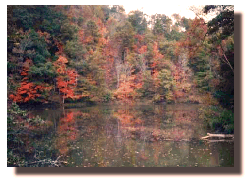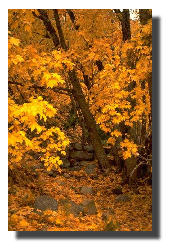Many people think that cold weather is solely responsible for the color change in leaves, but not so. Leaves begin to turn before we have any frosts. Change in coloring is the result of chemical processes which take place in the tree as the seasons change.
During the spring and summer a food-making process takes place in the leaves, within cells containing the pigment chlorophyll. This gives the leaf its green color. The chlorophyll absorbs energy from sunlight and uses it in transforming carbon dioxide and water to carbohydrates, such as sugars and starch.

In the fall the decrease in intensity and duration of sunlight, and the cooler temperatures cause the leaves to stop their food- making process. The chlorophyll breaks down, the green color disappears and the yellowish colors or other pigments already in the leaf become visible.
Autumn weather conditions favoring the most brilliant colors are warm sunny days and cool, but not freezing, nights. A few hard frosts can cause the leaves to wither and fall from the tree without changing color. The degree of color may also vary from tree to tree. Leaves directly exposed to the sun may turn red, while those on the shady side may be yellow. When warm, cloudy and rainy weather dominates the fall season, leaves tend to have less coloration.

In the Coulee Region, red and scarlet leaves can be found on red maple, red and black oak and sumac. Purple and burgundy can be seen on the green ash and white oak. Sugar maple is responsible for the brilliant oranges. Hickories turn a rich gold. Yellows are common for the trees native to the river floodplain, silver maple, elm, Cottonwood and white ash, as well as on the birch and aspen of the slopes and ridgetops.
Fall color in the Coulee Region usually peaks between the 10th and 15th of October, but this can vary by a week or so either way.
Rod Swerman - Retired NWS La Crosse, WI